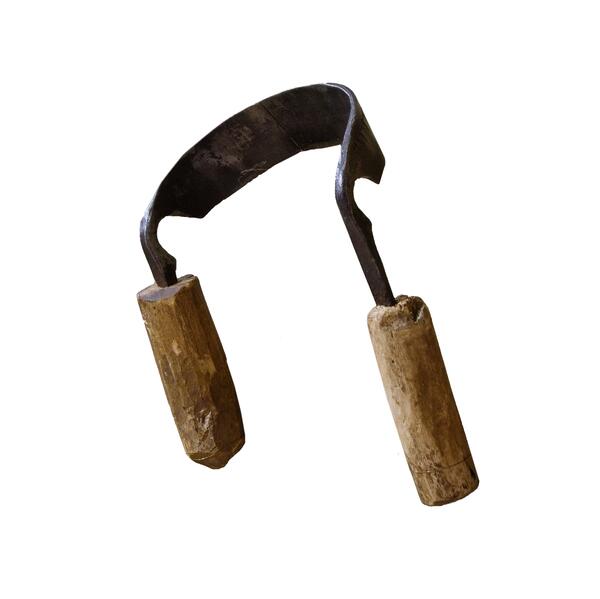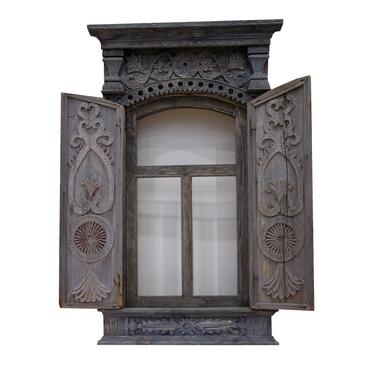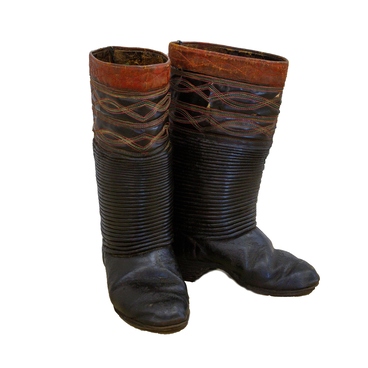The ethnographic expedition participants to the Staroshaygovsky and Krasnoslobodsky districts of the Republic of Mordovia donated the carpenter’s tool “skobel” (draw shave) to the museum. Galina Alamkin, a resident of the Meltsany village, Krasnoslobodsky Uyezd, Penza province was its owner. Skobel is an ancient cooper’s tool featuring a plain round-bent iron knife with a lower end cutting edge. Both pointed and bent at right angles ends of the knife — “shanks” — have wooden handles.
Large draw-shaves with a straight cutting edge up to 40 centimeters were used by coopers in ancient Novgorod since the 10th century. This is evidenced by archaeological finds of ancient tools.
The draw shave was used for removing log bark at the bast edge — “debarking”, without damaging the wood, and for simultaneous smoothing the surface of the logs, removing irregularities and small knots. The log was processed from the roots towards the top for barbed fiber and raised grains elimination. The skobel was also used to remove the “waves” from the lopped surface left by the axe and adz, and gave the surface perfect smoothness.
With the help of the draw shave, coopers made different containers. Such containers were made of separate shaves bound with hoops. First, their workpieces — “skolki” were dressed with an axe, and then dried in the sun and oven for several months.
The dried workpieces were whittled from the inside and outside with the draw shave. The cooper could change the thickness of the shavings by changing the cutting edge angle. An experienced craftsman would remove even shavings of the same thickness. Great practice and skill were required to use skobel skillfully. The development of cooperage in the Mordovian region started in the second half of the 17th century due to potash production growth. Coopers took part in potash (a type of salt), resin, and tar production. They were involved in making barrels for storing the substances.
At the turn of the 19th-20th centuries, cooperage was mostly developed in Saransk and Krasnoslobodsk uyezds. Local craftsmen received orders from the neighboring villages for vegetable pickling tubs, vats and barrels, buckets, measuring vessels, and troughs.
Large draw-shaves with a straight cutting edge up to 40 centimeters were used by coopers in ancient Novgorod since the 10th century. This is evidenced by archaeological finds of ancient tools.
The draw shave was used for removing log bark at the bast edge — “debarking”, without damaging the wood, and for simultaneous smoothing the surface of the logs, removing irregularities and small knots. The log was processed from the roots towards the top for barbed fiber and raised grains elimination. The skobel was also used to remove the “waves” from the lopped surface left by the axe and adz, and gave the surface perfect smoothness.
With the help of the draw shave, coopers made different containers. Such containers were made of separate shaves bound with hoops. First, their workpieces — “skolki” were dressed with an axe, and then dried in the sun and oven for several months.
The dried workpieces were whittled from the inside and outside with the draw shave. The cooper could change the thickness of the shavings by changing the cutting edge angle. An experienced craftsman would remove even shavings of the same thickness. Great practice and skill were required to use skobel skillfully. The development of cooperage in the Mordovian region started in the second half of the 17th century due to potash production growth. Coopers took part in potash (a type of salt), resin, and tar production. They were involved in making barrels for storing the substances.
At the turn of the 19th-20th centuries, cooperage was mostly developed in Saransk and Krasnoslobodsk uyezds. Local craftsmen received orders from the neighboring villages for vegetable pickling tubs, vats and barrels, buckets, measuring vessels, and troughs.



